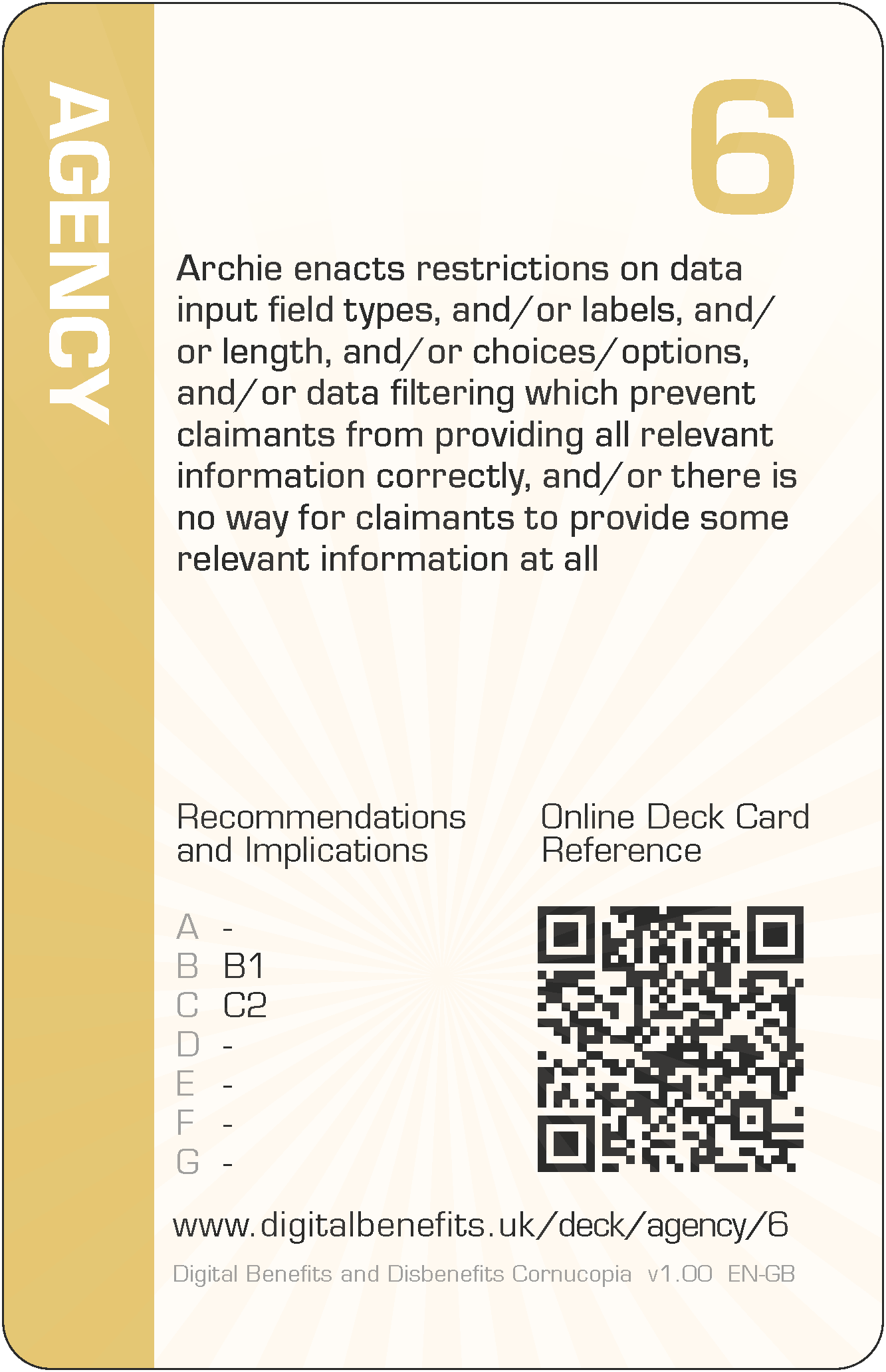Agency 6 (AG-6) Card
DBD Cornucopia > Deck > Agency > 6
Card Details - Six of Agency
Abbreviation
AG-6
Card's focus
The focus of this card is input constraints
Threat to claimants
Archie enacts restrictions on data input field types, and/or labels, and/or length, and/or choices/options, and/or data filtering which prevent claimants from providing all relevant information correctly, and/or there is no way for claimants to provide some relevant information at all

Threat to claimants
Archie enacts restrictions on data input field types, and/or labels, and/or length, and/or choices/options, and/or data filtering which prevent claimants from providing all relevant information correctly, and/or there is no way for claimants to provide some relevant information at all.
Some examples of how this threat could lead to harms (negative effects on claimants)
The design recommendations and implications relevant to the card are listed below in the next section, but even those can be somewhat abstract and difficult to think about during practical day-to-day implementation. Therefore, some example harms are provided to complement the more formal research outputs. These examples are unique per card, and are only published on these web pages (i.e. in no other project outputs).
- There is no option for the particular change of circumstances a claimant wants to report, so they have to send a message instead, leading to a delay to reporting the change, and an interim over payment of award which has to be deducted again later
- When an address or location is required, it is not possible for the claimant to select the correct address or location, and they are later accused of fraud
- The forms do not allow claimants to provide all relevant information, making claimants resort to providing additional information later which delays the process
The examples are to help understand the threat on the card, not to suppress thinking and innovation. Incorporating these examples exactly, or closely matching ones, should be scored down when playing DBD Cornucopia as a game.
Applicable design recommendations and implications
These are reproduced here from Research Briefing N
Acknowledge claimants as people in digital design
- Prioritise claimants' interests over system efficiencies
All digital welfare design processes, methods and decision-making should prioritise claimants' needs to achieve best outcomes for individuals rather than system efficiencies. Organisational knowledge and resources should be utilised to this respect including intervening in advance to identify matters that affect claims or what claimants may have forgotten about.
Reduce claimants’ interaction burdens with digital welfare
- Provide greater flexibility and accommodations for claimants in the accuracy, precision, timeliness and permanence of the remaining information they provide
Design for people's lives which can be complex and where changing events and circumstances, often beyond their control, drive their need and eligibility for social protection payments. Allow adequate, rather than complete and precise, data that suffice for the state's needs. Increase flexibility of use by avoiding strict deadlines; limiting the use of actions that block progression; permitting correcting, updating and reversing information; and withdraw penalties for simple slips and lapses.
General Notes
Card values (i.e. '6' for this card) are for game play and are not correlated with the severity of harm. This is because threats cannot be ranked directly since they can affect individuals in different ways due to situations and circumstances, or affect fewer or more claimants, or the harms can arise in claimants' support networks and wider society.
The threat description uses a person's name as the "attacker" (i.e. 'Archie' for this card), which can be thought of someone involved with implementation. They could have any role which influence digitisation. So they could be a database administrator, or a copy writer, or a quality assurance specialist, etc, or all of these. Everyone could have some influence on the claimant threat described. The names were randomly selected from those currently most popular as given names for boys and girls (UK Office for National Statistics).
The example harms provided are drawn from the research data (which explored not only parts of existing services but also the effects of possible changes to those), from the author's own knowledge of web application development and testing, the author's own experience of helping citizens to claim Universal Credit (UC) and Personal Independence Payment (PIP), and from suggestions submitted by other people (make a suggestion). The threats and example harms do not necessarily exist in the current UC or PIP deployments or in ecosystems around those services, but they might well do.
All the cards in this Agency suit are: 2 3 4 5 6 7 8 9 10 J Q K A
The other suits in the deck are: Scope, Architecture, Trust, Porosity and Cornucopia (plus Jokers).
